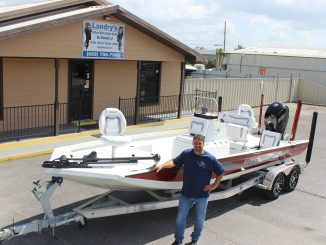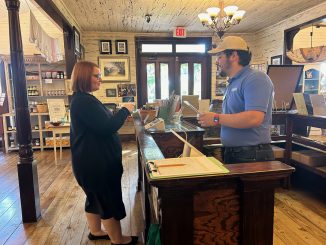
Destrehan resident owns a piece of history in Four Bayou fishing camp
The sky was darkening in the Gulf.
State Rep. Greg Miller, of Norco, was fishing with friends in the area east of Grand Isle.
The group started to boat back to Bridgeside Marina at Grand Isle but it was too late, the storm had moved into their path and there was no way around it.
“There was a big huge water spout probably about a mile away and the wind started whipping up. So we realized we weren’t going to be able to get back to the marina,” Miller said.
The anglers had been fishing for speckled trout near a number of dilapidated camps in the Four Bayou Pass area, but one camp they had been fishing near had a brand new dock and was still operational.
All of the boats fishing the area took refuge at this camp to escape from the storm. As luck would have it, the camp was opened up to the storm refugees thanks to the hospitality of two dentists from the West Bank who were friends of the camp owner. Miller soon discovered that the camp owner was none other than Mike Keegan from Destrehan.
The fishing camp is one of the last remaining functional camps in Four Bayou Pass between Grand Isle and Plaquemines Parish, an area that was once a thriving oyster community.
The structure has been in Keegan’s family since 1971 when his uncle bought it from the family who originally built it over 60 years ago. When the camp was built it was surrounded by marsh. Today it is surrounded by water yet still remains standing despite the odds.
“It was built in the 1950s by the Ziblich family. The Ziblich family was from Plaquemines Parish and ran an oyster operation,” Keegan said. “They had oyster leases all out that way and they lived out there. That was the last house they built.”
Keegan bought the camp with his brother in 1981 and last year became the sole owner when his brother passed away.
The camp was built to stand the test of time and has withstood numerous hurricanes throughout the years. Since the structure has been standing, around 30 hurricanes have passed over or by it including very destructive hurricanes such as Betsy in 1965, Katrina and Rita in 2005 and most recently Isaac in late August.
“It’s unreal the effort that went into building this place. It started off with those humongous creosote pilings that are still in excellent shape. There is no sign of being eaten out or anything,” Keegan said. “The way all of the framing of the camp was done there are three-quarter inch threaded rods that go all the way through the roofs and through the beams below to hold the camp down from tornadoes and what have you. It’s built really well, but there is always the threat of that one killer storm coming through and taking you out.”
The other camps in the area have been abandoned due to the continual upkeep and maintenance necessary to keep the camps structurally sound in the middle of open water.
Coming back to the camp after Hurricane Isaac, Keegan came to a startling realization.
“On the way over there I am a few miles away and I am counting them and I’m counting five am I’m ‘uh oh.’ So we got out there and two camps got washed away,” Keegan said. “There were seven camps in the area. Now there are five camps.”
Keegan’s camp received some damage in the hurricane, but nothing he said he cannot fix.
“We had 48 hours of wind and waves pounding, but the generator is still there and the generator runs. Water is there, we’ve got water, electricity and the roof stayed on,” Keegan said. “I had damage, but that is typical for a hurricane. It’s typical the dock gets busted up and about every four or five years it is what you get.”
That is how the camp has survived throughout the years, sturdy craftsmanship backed up by the will to continuously labor to maintain the building.
For Keegan all the work is worth it.
“It’s the best. People talking about going on vacation–I go on vacation every weekend. It’s like that. You don’t think about anything. You don’t worry about anything when you are out there. You definitely don’t think about work and we catch limits of speckled trout off the dock. Boats now come to us,” Keegan said.
However, hurricanes are not the worst of Keegan’s worries. He knows the days are numbered if coastal erosion is not reversed sometime soon.
“At one time where it is it use to be back up in the marsh. All of those camps. Most of the those camps were back up in the marsh, now the marsh has all washed away and there is no protection,” Keegan said. “I’ve been talking about it and watching it happen since the 1970s. Just watching it go. When you watch the shoreline just coming closer and closer and closer and watch the marsh erode from inside itself. It just starts getting thinner and thinner and there’s just nothing left there.”
The Gulf of Mexico has slowly been encroaching on the property and is now about a mile and half away. Keegan said if coastal erosion keeps progressing at the rate it has been his camp will eventually be swept into the ocean. However, he hopes he can save it.
“The only way that is going to happen is if we can prevent coastal erosion and start ensuring the shoreline doesn’t come in any further in,” Keegan said. “Once we are in the Gulf it is all over with.”
Still, Keegan is optimistic that his children will take over the camp in the future.
“My kids love that place,” Keegan said. “Once they became teenagers one of the few things that they wanted to do with Dad was go to the camp. It’s always been a good place for family to get together.
“Hopefully I can teach them what it takes to put it all back together again after a big storm like we just had.”
Keegan said his son has already begun to take on maintenance duties and they, along with their friends, will be repairing damage done by Isaac.
They know there will be another storm and that coastal erosion is not likely to abate anytime soon, but in the meantime Keegan and his friends and family are planning on doing what they’ve been doing for the past 40 years–enjoy their piece of history.
“You can’t build them anymore. The only way you can get them is if you buy somebody else’s place. It’s very unique. There’s nothing better than being out there. Every sunset is different,” Keegan said.




Be the first to comment